 |
124 Spider / Volvo Radiator Conversion
Author: Richard Ridge
ridgevitale@mac.com
Date: Fri, September 8, 2006 |
Introduction
When the original radiator in my 1981 Spider was showing signs of needing a third trip to the radiator shop in 8 years I finally got serious about finding an alternative. I had previously rejected an aftermarket brass radiator because it was too lightly made. A reproduction all-aluminum radiator is now available but it does not have provision for a fan sensor and costs about $450.
That's actually a very reasonable price for a handmade custom unit. If I had gone in Mike Julian's direction I would have saved a lot of hours. But why copy a 40 year old radiator design. Both the design and manufacturing technology have moved on. Also when the Volvo radiator silts up or springs a leak, I will recycle the parts get another one at my local auto store. Does anyone believe 240's will disappear from the road in the next decade?
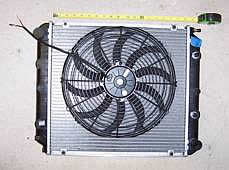 After doing some research in the Archive and on the web, I focused on the new aftermarket aluminum/plastic radiator that is now made for the Volvo 240 and early 740 models. It is a close match in overall dimensions, uses the same 1 1/4 in inlet and outlet in the same positions and is quite cheap. At the time I bought it, the Chinese made unit went for $105. It appears to use the Modine oven brazing process. Like most overseas parts it has recently gone up in price. Since my bi-annual radiator overhauls were running $100 a pop the economics were attractive even though it meant I also needed an new fan.
After doing some research in the Archive and on the web, I focused on the new aftermarket aluminum/plastic radiator that is now made for the Volvo 240 and early 740 models. It is a close match in overall dimensions, uses the same 1 1/4 in inlet and outlet in the same positions and is quite cheap. At the time I bought it, the Chinese made unit went for $105. It appears to use the Modine oven brazing process. Like most overseas parts it has recently gone up in price. Since my bi-annual radiator overhauls were running $100 a pop the economics were attractive even though it meant I also needed an new fan.
Because the Volvo radiator is slightly taller than the stock one, the top edge must be set back from the top radiator cross member moving it closer to the front of the engine. Because it is a cross flow design there are no mounting points on the sides for a fan. For these reasons, a slimmer electric fan with different mounting points must be substituted. There are a wide range of choices in the 12 to 16 inch diameter sizes that will match or outperform the stock fan and fit the Volvo radiator. And again they are no more expensive than overhauling the original.
Not surprisingly, Mirafiori members had already led the way down this radiator conversion path. Pete Angel was stuffing Scirocco radiators in 124's before there was an internet. Eladio Garcia posted part numbers and pictures of the Volvo/Spider conversion on his web site in 2003. Ralph DeLaurentis had done the conversion and shared his experience here. Robert McNabb recently bought Ralph's set up after reading about it on Mira he too provided me with useful details and support.
My own contributions are fairly modest. I've used a 940 bottle in a Spider for perhaps the first time, found a little more clearance down below and provided some clean up of the upper mount details.
Installation
The fan I used is a Spal unit which I picked up on eBay, slightly used for $75. The stock Volvo 240 fan is engine driven. The temp sensor in the radiator was originally added to trigger an auxiliary fan in front of the radiator for a/c cooling, Later 740's and 940's have an electric puller also but the radiator and shroud are wider and don't fit our opening.
Spal sells a wide variety of mounting feet and brackets to fit their units and has a good web site, While the fans themselves are overpriced in the Spal webstore but the mounting hardware is actually cheaper when purchased from Spal directly.
The existing Spider lower radiator bracket under the center is reused. Clearance between the lower hose outlet and the sway bar is close. I used the original Fiat rubber bracket pad and reinforced the bottom of the radiator with two pieces of aluminum extrusion to give the needed half inch clearance.
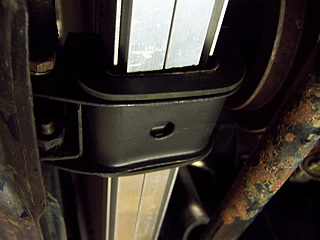 The aluminum was cut and bonded to the bottom channel with RTV silicone. It's a three sided angle extrusion with the open side facing up towards the bottom of the new radiator. It is notched at each end to allow a tab to extend under the plastic end tanks.
The aluminum was cut and bonded to the bottom channel with RTV silicone. It's a three sided angle extrusion with the open side facing up towards the bottom of the new radiator. It is notched at each end to allow a tab to extend under the plastic end tanks.
Like most modern radiators it is quite fragile. The joints between the plastic tanks and aluminum tubes are easily damaged by pulling on the hoses, The aluminum fins are one grade above food wrap and easily crushed. However, the half inch wide cooling tubes are actually multiple tubes extruded side by side and the fins are brazed onto them were each touches. The radiator appears capable of spreading the load of a single lower mount.
Because the Fiat lower bracket was not designed to carry the full weight of the original radiator and will pivot off its two small bolts, I have some concern about its sagging down, I plan to run a support strap from my oil pan guard to its underside when I get the guard back on, But others report no problems in longer term road use. The empty radiator and fan combo is eleven pounds lighter than the stock Fiat units and it appears to hold less coolant.
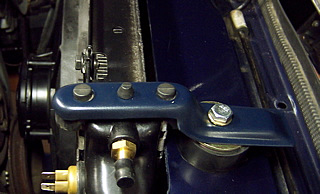 The top brackets are the original Volvo brackets. They bolt to the top cross member using new holes on the top surface and existing factory holes in the underside. The brackets clamp on the tank seams on each side of the radiator with molded rubber pads. Both those seams and the exiting cross member holes are exactly 18 inches apart.
The top brackets are the original Volvo brackets. They bolt to the top cross member using new holes on the top surface and existing factory holes in the underside. The brackets clamp on the tank seams on each side of the radiator with molded rubber pads. Both those seams and the exiting cross member holes are exactly 18 inches apart.
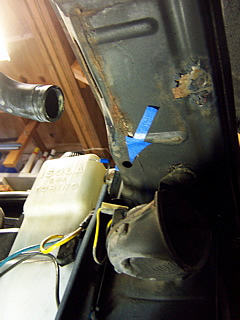 Matching 5/8 holes must be drilled in the top side of the cross member. The holes are 1 1/4 inch forward of the cross member's rear edge. The holes receives the 3 1/2" hex bolts that hold down the Volvo top brackets.
Matching 5/8 holes must be drilled in the top side of the cross member. The holes are 1 1/4 inch forward of the cross member's rear edge. The holes receives the 3 1/2" hex bolts that hold down the Volvo top brackets.
The radiator is slightly taller than the top cross member. Spacers must be placed between the cross member and the top mounts. I used the rubber plugs from "Expand Tite" kits to raise the brackets up by the required 3/4". A large plated washer from the kit sits between the brackets and the rubber, which is supplied with the correct hole size. The top side of the cross member is flat, light gage sheet metal and will not take a concentrated load, The rubber donuts also serve to spread the load out a bit.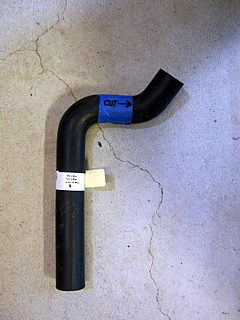
The upper radiator hose is cut down from Auto Zone hose of unknown origin. I simply followed Eladio Garcia's part number recommendation. (picture five) His recommended lower hose part number did not work for me.
Since the Fiat upper hose is replaced, it is available to supply the needed 90 bend at the bottom of the radiator outlet. The Volvo's lower radiator hose connection projects straight out, lacking the 90 degree metal elbow of the stock radiator. I used a 1 1/4" hose splice to connect the bent end of the upper hose with the existing lower hose on the thermostat.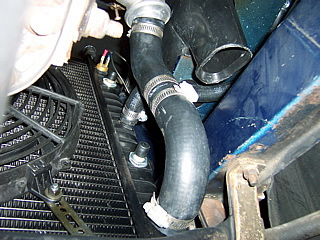
The Volvo radiator does not have a radiator cap. A separate expansion tank takes the place of the Fiat coolant recovery bottle. A 5/8" line links the middle of the passenger side radiator tank with a fitting on the underside of the bottle. A second 5/16" line links a brass nipple on the top of the radiator with a similar nipple on top of the bottle to bleed any air out of the radiator.
The 940 bottle itself is rectangular and fits in the space vacated by the Fiat bottle. It must be mounted as high in the engine compartment as possible because the coolant level in the bottle is the coolant level in the head as well. The max coolant level in my bottle is at the same level as the lip running across the back of the engine compartment.
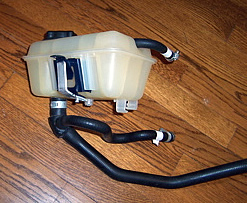 The stock Fiat system was designed for only 11 psi pressurization. In deference to my 25 year old heater core I did not use the 940 bottle cap which is rated at 22 psi (150 KPa). Volvo caps are color coded and marked in KPa. You want the black one that's marked "75 KPa".
The stock Fiat system was designed for only 11 psi pressurization. In deference to my 25 year old heater core I did not use the 940 bottle cap which is rated at 22 psi (150 KPa). Volvo caps are color coded and marked in KPa. You want the black one that's marked "75 KPa".
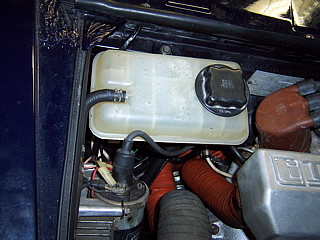 The bottle is mounted above the original 124 bottle mounts using the 940's steel bracket. That bracket is welded to the inner fender of the donor car but can be removed by drilling out the two spot welds that hold it.
The bottle is mounted above the original 124 bottle mounts using the 940's steel bracket. That bracket is welded to the inner fender of the donor car but can be removed by drilling out the two spot welds that hold it.
The 740 bottle comes with a simpler bracket setup. I used the 940 bottle because it was more compact and I needed the space for my Legend Turbo installation.
I used a stock Volvo sensor in a new gasket that came with the radiator. The sensor is held in the radiator tank by nothing more than its slightly hourglass shape and the compression of the gasket, The used Volvo parts specialist I dealt with recommended some RTV to seal it in place. This mounting design came from Volvo so it has stood the test of time.
I do not know what year or model Volvo my particular sensor came from. I've been told that it was made in a range of temps but I see only one new one out there. Mine was made by Klixon and was marked "92-97" which I assume are the actuation temps in C. The radiator came with a white nylon plug to substitute for the sensor in the tank opening.,
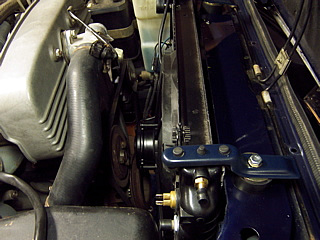 Electrical hook up of the fan did not use the stock harness because I had no relay in the circuit and was concerned about overloading it. The Spal fan is rated at 17 amps. My stock fan draws only 10-12. I put a new supply line in from the alternator, fused it in-line and ran it through a 30 amp Bosch relay. The sensor sees only the trigger current. Power remains available after the key is off, just like stock '81 Spiders. Fan wiring detail on Spiders varies from year to year.
Electrical hook up of the fan did not use the stock harness because I had no relay in the circuit and was concerned about overloading it. The Spal fan is rated at 17 amps. My stock fan draws only 10-12. I put a new supply line in from the alternator, fused it in-line and ran it through a 30 amp Bosch relay. The sensor sees only the trigger current. Power remains available after the key is off, just like stock '81 Spiders. Fan wiring detail on Spiders varies from year to year.
To facilitate the conversion, I've made liberal use of plastic hose splices in the lower radiator hose and in the two lines to the bottle. I don't recommend them as a long term solution,. Unfortunately, I was not able to find a lower hose with the right geometry and end diameters.
A hose to connect the outlet with the water pump directly does appear to be available for those running internal thermostats and I will post details when I have tested it. The online Gates hose catalog is a wonderful parts substitution resource.
Driving Experience
The car runs a bit cooler. No surprise when a new radiator replaces a 25 year old one. The fan comes on less in traffic. When it does, fan noise is higher, with a well defined tone that is characteristic of evenly spaced blades interacting with air flow off evenly spaced vanes. Since I sized the fan for eventual a/c installation, it has excess cooling capacity. I will investigate a speed controls to lower fan noise when the a/c is not in use. Moving the fan slightly off the radiator face or finding a fan with staggered blade spacing are also options. Fourteen inch fans from older mid-sized FWD cars are a dime a dozen in wreaking yards. Most OEM fans are are designed for low noise.
The stock Volvo temp sensor works like it was made for my car. Kicks the fan on at a slightly lower temp. Could be the result of the sensor being mounted at the top of the radiator rather than the bottom. It kicks off just a few degrees above the thermostat opening. Temp gauge needle moves in a narrow range between 189 and 195 indicated.
The pressurized coolant bottle does a better job of getting air out of the system. The coolant level has stayed rock steady since the original bleeding was done. However, until the thermostat opens for the first time, it is still a struggle to get air out of the external thermostat. For this reason and to clean up the engine compartment, I plan to convert to the in-head thermostat configuration.
Pay close attention to the coolant level. If the tank is properly positioned it will start cold with the coolant at minimum and as it heats, the coolant will approach maximum. If too much coolant is added cold, the tank will overflow. It vents under the cap. There is no overflow line, so a mess will ensue. Remember this when you are routing wiring in the vicinity.
And speaking of cap, recall that the bottle is now pressurized. When you twirl off the handy plastic tank cap, you are actually taking off the radiator cap and releasing the pressure. Don't do it while coolant is hot
Parts list
Volvo 240/740 aftermarket radiator: parallel flow aluminum cooling
tubes, brazed aluminum fins, plastic side tanks, mounting hole with
gasket for press-in temp sensor, mounting holes on upper and lower
channel for electric fan, Ready-Rad Radiator p/n 433267, Advance Auto/
www.partsamerica.com.
48" length of three sided 1/2" aluminum extrusion to reinforce
radiator bottom ,Home Depot.
Volvo 240 coolant bottle black pressure cap, 75 Kpa (11psi), used.
Volvo 240 Klixon temp sensor press-in style, marked "92-97", used.
Volvo 940 coolant bottle: used, need mounting bracket (use a spot weld
cutter to extract from donor car), need bottle to radiator hose
attached to underside of bottle, need radiator air bleed line attached
to top, throw away blue 150 Kpa cap that comes with it.
Upper radiator hose: new, Auto Zone pn M477, cut to fit.
|
Lower radiator hose: used, splice existing upper and lower radiator
hoses together with a 1 1/4 hose splice.
Radiator to bottle coolant hose: at radiator outlet - new Gates
molded 5/8" with 90 bend, pn 28467, at radiator bottle- used Volvo 940
OEM hose with extra short leg unused and plugged, 5/8 to 5/8 heater
hose splicer.
Raditator to bottle air hose: used 940 hose out of radiator air bleed,
new 5/16 "HELP" brand molded emissions control hose with 90 bend at
bottle end, 5/16" brass hose splice connecting the two
Top radiator mounts: (2)Volvo 240/740 radiator hold downs - used, (2)
1 7/8" dia x 3/4" high rubber blocks, "Expand-Tite" rubber plug,
Dorfman pn 571-012, Advance Auto, (2) 3 1/2 inch 5/8 hex bolts and
nuts.
Electric fan: Spal - used, 14inch high performance (1720 cfm), puller
config, curved blades, part number 30102042.
Fan mounting kit: Spal - new, plastic feet with metal straps, part
number 30130011. |